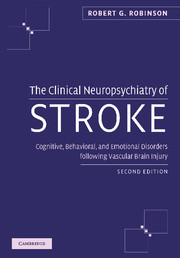 The Clinical Neuropsychiatry of Stroke
The Clinical Neuropsychiatry of Stroke Book contents
- Frontmatter
- Contents
- Preface
- Part I Introduction
- Part II Poststroke depression
- Part III Poststroke mania
- Part IV Poststroke anxiety disorders
- 29 Prevalence and specificity of clinical symptoms
- 30 Clinical and lesion correlates
- 31 Longitudinal course
- 32 Relationship of anxiety to outcome
- 33 Mechanism and treatment of poststroke anxiety disorder
- Part V Other poststroke disorders
- Index
32 - Relationship of anxiety to outcome
from Part IV - Poststroke anxiety disorders
Published online by Cambridge University Press: 01 October 2009
- Frontmatter
- Contents
- Preface
- Part I Introduction
- Part II Poststroke depression
- Part III Poststroke mania
- Part IV Poststroke anxiety disorders
- 29 Prevalence and specificity of clinical symptoms
- 30 Clinical and lesion correlates
- 31 Longitudinal course
- 32 Relationship of anxiety to outcome
- 33 Mechanism and treatment of poststroke anxiety disorder
- Part V Other poststroke disorders
- Index
Summary
For many years clinicians have recognized the importance of anxiety disorder as well as depression in patients following stroke (Schwartzman 1976). The spectrum of anxiety disorders includes panic disorder, generalized anxiety disorder (GAD), obsessive compulsive disorder (OCD) and phobic disorders. There have been anecdotal reports of panic disorder (Maricle et al. 1991) and OCD occurring in patients with stroke. These are relatively rare conditions arising from ischemic brain injury. Our research investigations have not systematically examined patients for panic disorder or OCD. We have, however, systematically examined patients for GAD. Although this has not been a major area of investigation for other researchers, there are a number of reports of the presentation, diagnosis, and clinical and pathological correlates of poststroke anxiety disorder (Burvill et al. 1995; Astrom 1996).
In contrast to the relatively large number of studies which have examined the relationship between the existence of poststroke depression and physical and cognitive recovery following stroke, relatively few studies have examined the effect of anxiety disorder on physical and cognitive recovery from stroke. We examined 142 consecutive patients who were evaluated following acute stroke and followed-up at either 3 or 6 months (n = 110) or 12 or 24 months follow-up (n = 103) (Shimoda and Robinson 1998).
- Type
- Chapter
- Information
- The Clinical Neuropsychiatry of StrokeCognitive, Behavioral and Emotional Disorders following Vascular Brain Injury, pp. 341 - 346Publisher: Cambridge University PressPrint publication year: 2006


